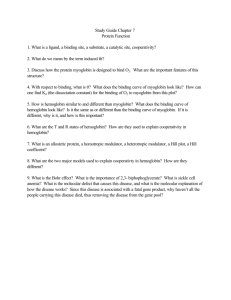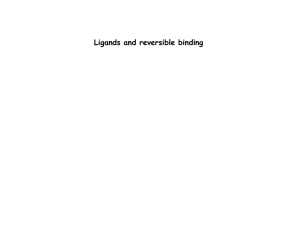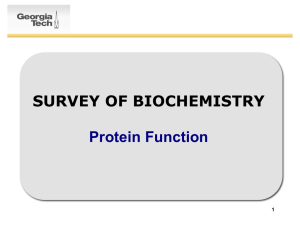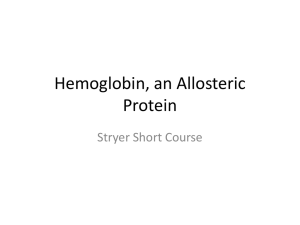Document 15549570
advertisement
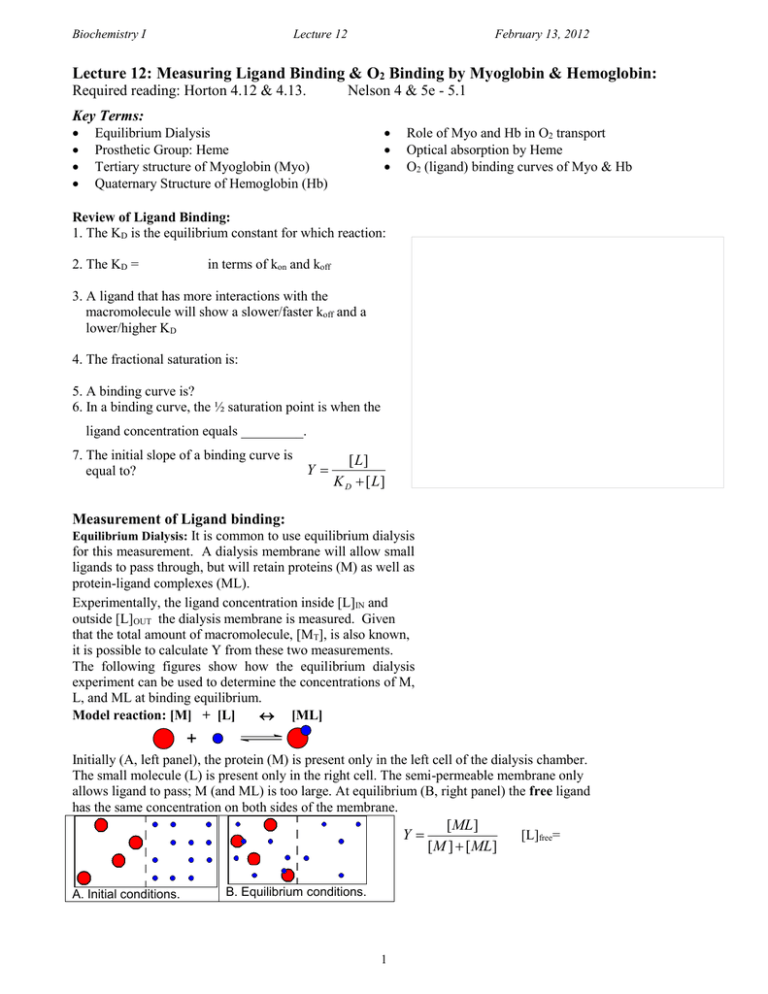
Biochemistry I Lecture 12 February 13, 2012 Lecture 12: Measuring Ligand Binding & O2 Binding by Myoglobin & Hemoglobin: Required reading: Horton 4.12 & 4.13. Nelson 4 & 5e - 5.1 Key Terms: Equilibrium Dialysis Prosthetic Group: Heme Tertiary structure of Myoglobin (Myo) Quaternary Structure of Hemoglobin (Hb) Role of Myo and Hb in O2 transport Optical absorption by Heme O2 (ligand) binding curves of Myo & Hb Review of Ligand Binding: 1. The KD is the equilibrium constant for which reaction: 2. The KD = in terms of kon and koff 3. A ligand that has more interactions with the macromolecule will show a slower/faster koff and a lower/higher KD 4. The fractional saturation is: 5. A binding curve is? 6. In a binding curve, the ½ saturation point is when the ligand concentration equals _________. 7. The initial slope of a binding curve is Y equal to? [ L] K D [ L] Measurement of Ligand binding: Equilibrium Dialysis: It is common to use equilibrium dialysis for this measurement. A dialysis membrane will allow small ligands to pass through, but will retain proteins (M) as well as protein-ligand complexes (ML). Experimentally, the ligand concentration inside [L]IN and outside [L]OUT the dialysis membrane is measured. Given that the total amount of macromolecule, [MT], is also known, it is possible to calculate Y from these two measurements. The following figures show how the equilibrium dialysis experiment can be used to determine the concentrations of M, L, and ML at binding equilibrium. Model reaction: [M] + [L] [ML] + Initially (A, left panel), the protein (M) is present only in the left cell of the dialysis chamber. The small molecule (L) is present only in the right cell. The semi-permeable membrane only allows ligand to pass; M (and ML) is too large. At equilibrium (B, right panel) the free ligand has the same concentration on both sides of the membrane. Y A. Initial conditions. B. Equilibrium conditions. 1 [ ML] [ M ] [ ML] [L]free= Biochemistry I Lecture 12 February 13, 2012 Sample Ligand Binding Problem : Two biotech companies (“Abs R us” and “Drug [ L] Busters”) produce antibodies to treat drug overdose Y K D [ L] from PCP. Measured fractional saturation and binding curves for PCP binding to Fab fragments of both of these antibodies are shown to the right. Binding Curve - Anti-PCP Antibodies Y [Abs R us] 0.34 0.50 0.67 0.80 0.89 Y [Drug Busters] 0.14 0.25 0.40 0.57 0.73 0.9 Fractional Saturation [PCP]uM 5 10 20 40 80 1 0.8 0.7 0.6 0.5 0.4 0.3 0.2 0.1 0 0 1. What are the KDs for each antibody? Abs R us : Drug Busters : 10 20 30 40 Abs R us 50 60 Drug Busters Drug Busters Abs R us 2. Which company has the better product? (Which antibody will bind more PCP at any given PCP concentration? Which has the lower KD value?) 3. Explain the KD values based on the structure of the complexes. 4. The entropy change, ΔSo, during binding for either antibody, is positive. Why? Oxygen Transport: CH3 12A. General features of oxygen transport: Oxygen is absolutely required for life in most organisms. All tissues need oxygen. Oxygen is usually taken up in the lungs by the protein Hemoglobin and carried throughout the body in the circulatory system. In some cases, there is a need to store large quantities of oxygen in the tissue itself. In this case a specialized oxygen storage protein, Myoglobin, is used to store the oxygen and to facilitate its diffusion within cells. H3C N Fe N 2+ N N H3C CH3 CH2CH2COOCH2CH2COO- 12B. Structural Features of Myoglobin and Hemoglobin Properties of heme group Example of a prosthetic group in proteins. A prosthetic group is usually an organic compound or a metal ion what is tightly bound to the protein and plays an essential role in the function of that protein. Heterocyclic ring containing 4 pyrrole rings Central atom is Fe2+ (usual oxidation state) in Myo and Hb 2 70 80 [PCP] uM Biochemistry I Lecture 12 February 13, 2012 Proximal histidine is important in transducing the binding event to other protein subunits in hemoglobin. HN N Myoglobin (Mb) Monomeric (tertiary structure) Contains a single heme group with a bound Fe2+ Binds 1 oxygen molecule per molecule of protein.. Stores/carries O2 from capillaries to sites of usage in cells. (i.e. mitochondria) H 3C H 3C H 3C 2+ N Fe N N N R1 R1 CH 3 N N H Hemoglogin (Hb) Tetrametric, two alpha chains and two beta chains (Quaternary Structure) Each chain is structurally similar to myoglobin Each chain contains a bound heme-Fe2+ Binds a total of 4 oxygen molecules to its four heme groups. Carries O2 from lungs to tissues, increasing the solubility of O2 in blood Spectral changes due to Oxygen binding. Heme group absorbs visible light Absorption spectrum can be used to measure the relative amount of oxygenated Hb. Absorption at ~675 nm can be used to determine relative amounts of oxy and deoxy hemoglobin. f DeOxy Oxy A675 A675 Deoxy Oxy A675 A675 Molar Extitinction Coefficient Absorption of Deoxy and Oxy Hemoglobin 1000000 100000 10000 HbO2 Hb (deoxy) 1000 100 200 400 600 Wavelength (nm) 3 800 1000 Biochemistry I Lecture 12 February 13, 2012 12C. Oxygen Binding: The binding equilibrium, using myoglobin (M) as an example is: M + O2 (M O2) The ligand concentration is given as pO2, or the partial pressure of oxygen. The units are in kPa or in Torr. The fractional saturation is given as the following for the case of myoglobin (single oxygen bound): Y pO2 [ L] K D pO2 K D [ L] For oxygen binding proteins the KD is also referred to as the “p50”, the amount of oxygen required to give a fractional saturation of Y=0.5. In the case of myoglobin, the KD is about 0.25 kPa. 12D. Oxygen Delivery – The cooperative binding of Oxygen to Hemoglobin: The efficient delivery of oxygen to the tissues presents a difficult problem. How do you design a protein that will bind oxygen well in the lungs and then efficiently release that oxygen in the tissues where it can be bound by myoglobin. A comparison of the oxygen binding curves of myoglobin and hemoglobin shows how this works. Theta Oxygen Binding 1 0.9 0.8 0.7 0.6 0.5 0.4 0.3 0.2 0.1 0 0 2 4 6 8 10 12 14 16 pO2 kPa The strange binding behavior for the hemoglobin binding curve is due entirely to the fact that it can bind oxygen in a cooperative fashion: The affinity (KA) increases as more oxygen is bound, favoring loading of O2 in the lungs. As the hemoglobin goes out to the tissues, oxygen is lost. The affinity decreases as less oxygen is bound, favoring further release of O2 in the tissues. Hemoglobin In the lungs [O2] ~12 kPa Y= At the tissues [O2] ~ 3 kPa Y= Myoglobin Y= 4
